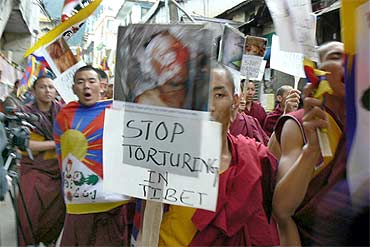 | « Back to article | Print this article |
Taking Tibet to the world
Earlier this year, a battle broke out between a small documentary that tracks the struggle for Tibet's independence and the government of China. The documentary, The Sun Behind The Clouds: Tibet's Struggle For Freedom, was scheduled to be shown at the Palm Spring International Film Festival in January. Embarrassed by the footage of Chinese brutality and suppression of the 2008 uprising in Tibet, China requested that the film be withdrawn.
But the festival authorities refused. 'We cannot allow the concerns of one country or community, based on their own cultural or political perspective, to dictate what films we should or should not play,' festival director Darryl Macdonald said in a statement. 'Freedom of expression is integral both to the validity of artistic events, and to the ethos of this country."
In retaliation, China's state-run China Film Group pulled out its two films showing at the festival Quick, Quick, Slow and City Of Life And Death. Ironically, City Of Life And Death deals with a similar theme the Japanese massacre of Chinese people during the 1937 Battle of Nanjing.
The events at Palm Spring are a great endorsement for The Sun Behind The Clouds, directed by Tenzing Sonam and his partner Ritu Sarin, which premiered in the United States March 31.

Controversy apart, this film is a well-made, moving documentary that tracks all sides of the Tibetan issue. At the center of it is the Dalai Lama's middle-way approach--giving up the goal of Tibet's independence for some form of autonomy. Clashing with his perspective are the younger generation of Tibetan exiles in India and other intellectuals who want total independence.
The two views collided in 2008 when Tibetan protesters tried to stop the Beijing Olympic torch rallies in various parts of the world and anti-China protests erupted within Tibet. At the same time, a group of pro-independence supporters in India decided to march to Tibet. The issue became an embarrassment for the Indian government and, in one of the saddest sections of the film, the marchers were arrested as they neared the Tibetan border.
"Initially, our idea was to do a film commemorating the 50th anniversary of March 1959 by examining where the Tibet movement was 50 years after the Dalai Lama went into exile," Sarin recently wrote in an e-mail interview as she and Sonam prepared for the theatrical premiere of their film in New York City's art house theater Film Forum. They wanted to focus on the debate between the Dalai Lama and pro-independence supporters. But as it often happens in the world of documentary filmmaking, current events changed the tone of the film. "Suddenly, we were following dynamic events," Sarin said about the film that was shot in India, China, Tibet, the US, France, Germany and the UK.
Taking Tibet to the world
The Sun Behind The Clouds is packed with rare footage. The film shows some intimate moments with the Dalai Lama--his prayers in his private quarters, his walks around his house in Dharamsala, his meetings with world leaders, a recent press conference for the Chinese media, his disappointment as the pro-independence marchers head to the border of Tibet and a delightful moment when he jokes with Prince Charles and his wife Camilla.
"We have been filming the Dalai Lama since 1986, when we travelled with him on a European tour," Sarin said. "We filmed his visit to Norway in 1989 to accept the Nobel Peace Prize, and covered his travels through the Russian Buddhist republics of Kalmykia, Buryatia and Aginski in 1991. However, in recent years, as his international stature has grown, it has become harder to gain access to him." But when the filmmakers approached the Dalai Lama's office, he was supportive. "This made it a lot easier to have the access we finally got," she said.
The film also shows detailed shots of the 2008 protests in Tibet. In addition, the filmmakers were able to get hold of never-before seen footage that shows Chinese people migrating to Tibet, and street scenes of modern day Lhasa. Among the talking heads in the film is inspiring Tibetan blogger Woeser, who was forced to leave Lhasa for writing sympathetically about the Dalai Lama. Sonam and Sarin traveled to Beijing to interview her.
"Woeser is a heroic figure among Tibetans today, one of the few voices from inside China that openly criticize the Chinese government's rule in Tibet," Sarin said. "She turned out to be a lovely person, full of life and passionately committed to the Tibetan cause, yet mischievous and fun-loving. We are very concerned for her safety."
The Sun Behind The Clouds ends in what appears to be lack of hope for Tibet. Despite protests, the Beijing Olympics were a success and the Chinese government seems to have back peddled on some of the promises it made to the Dalai Lama and his team. But Sonam and Sarin have not lost hope.
"Looking at Tibet objectively, it would seem to be a hopeless situation," Sarin said. "But Tibetans do not have the luxury of pessimism. After the events of 2008, there is a resurgence of nationalism among Tibetans in Tibet, particularly the younger generation. They are expressing their identity and dissent in subtle ways. Also, there is every chance that China will not be able to sustain its present form of government for very long. When change comes to China, there is every possibility of change in Tibet. We live in hope in what seems like a hopeless situation."

